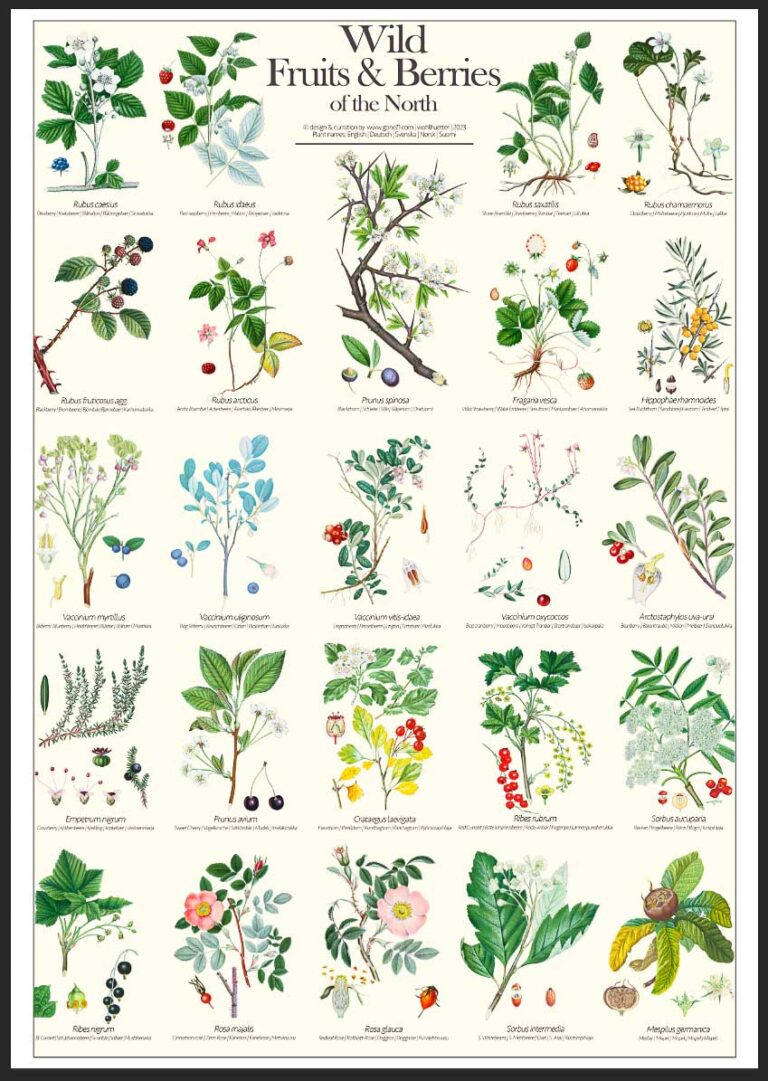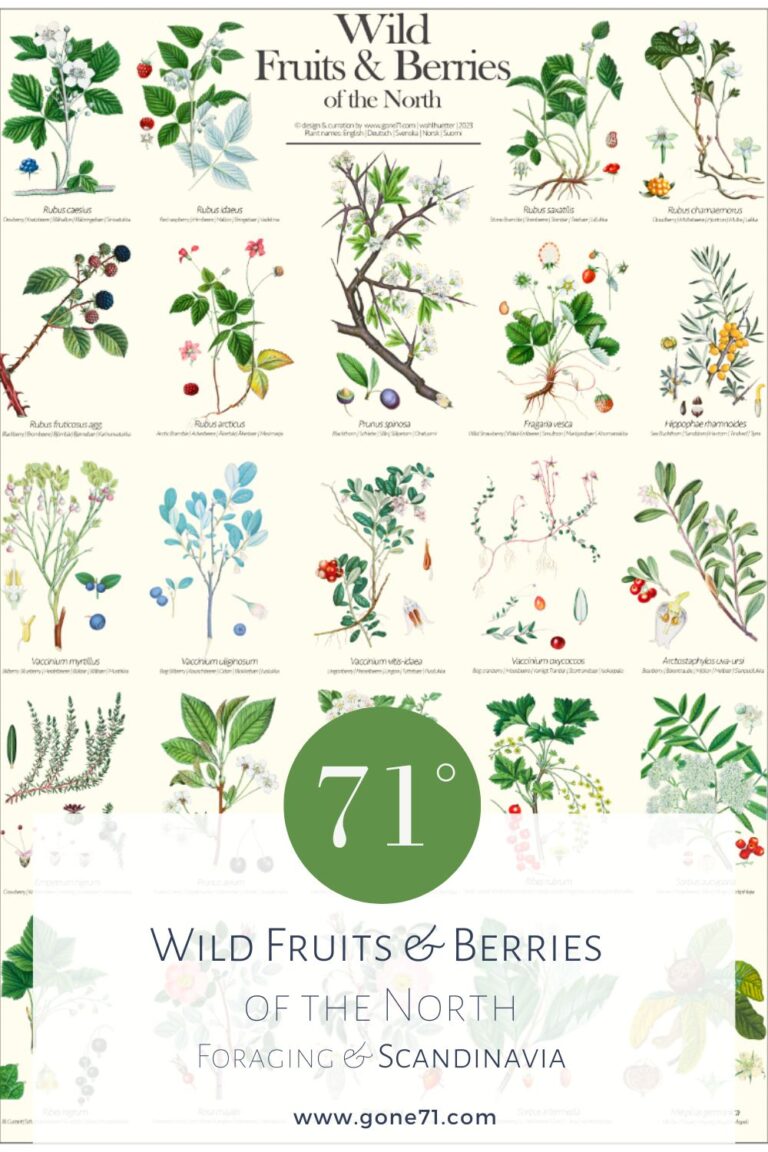Introducing our new “Wild Berries & Fruits of the North” poster. This digital educational poster is the perfect addition to any wild fruit enthusiast, Scandinavian enthusiast, forager or vintage lover’s collection. It features an array of vibrant, illustrated wild berries and fruits commonly found in Northern Europe and Scandinavia, accompanied by their scientific, English, German, Swedish, Norwegian and Finnish names. This poster will not only add a touch of vintage charm to any room, but it will also serve as a valuable learning tool for foragers and nature enthusiasts alike. Discover the richness and diversity of Scandinavia’s wild fruits and berries with this comprehensive and visually stunning poster.
About the poster
When it comes to art posters, size can matter. And what better way to showcase the intricate details of botanical illustrations than with a high resolution poster?
Measuring in at a massive 841mm x 1189mm in its original format, this poster is sure to make a statement in any room. Each individual plant is derived from scientific lithographic illustrations, providing not only a beautiful display but also a glimpse into the past. The intricate details of each leaf, petal, and stem are captured in stunning clarity, thanks to the high resolution printing process.

These posters are not just for decoration, but also for education. The detailed illustrations provide an opportunity to study the different parts of the plants and learn more about their characteristics.
In short, these posters are a perfect blend of art and science, making them a unique addition to any home, office or classroom. And with its classic and timeless design, it is a piece of art that will never go out of style.

The featured species
Scandinavia is home to a wide variety of wild fruits and berries, many of which are unique to the region. These wild fruits and berries can be found growing in a variety of habitats, from dense forests to rocky mountainsides. Some of the most popular wild fruits and berries in Scandinavia include:
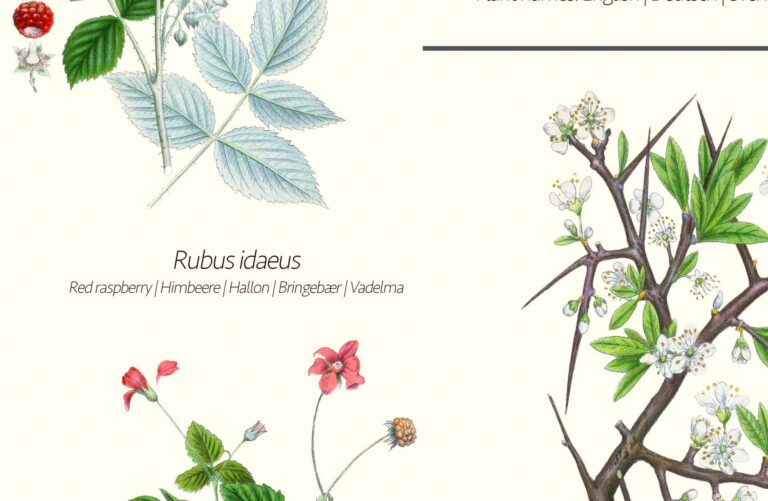
Rubus caesius (Dewberry)
is a small, creeping shrub that is commonly found in woodlands and hedgerows throughout Scandinavia. The fruit is a small, blackberry-like berry that is typically picked in late summer. The berries are known for their sweet and tangy flavor and are often used to make jams and jellies.
Rubus idaeus (Red raspberry)
is a tall, thorny shrub that is commonly found in woodlands and hedgerows throughout Scandinavia. The fruit is a bright red, raspberry-like berry that is typically picked in late summer. The berries are known for their sweet and juicy flavor and are often used to make jams, jellies, and pies.
Rubus saxatilis (Stone Bramble)
is a small, thorny shrub that is commonly found growing on rocky outcrops and mountainsides throughout Scandinavia. The fruit is a small, blackberry-like berry that is typically picked in late summer. The berries are known for their sweet and tangy flavor and are often used to make jams and jellies.
Rubus chamaemorus (Cloudberry)
is a small, creeping shrub that is commonly found growing in bogs and marshlands throughout Scandinavia. The fruit is a small, yellow-orange berry that is typically picked in late summer. The berries are known for their sweet and tangy flavor and are often used to make jams, jellies, and pies.
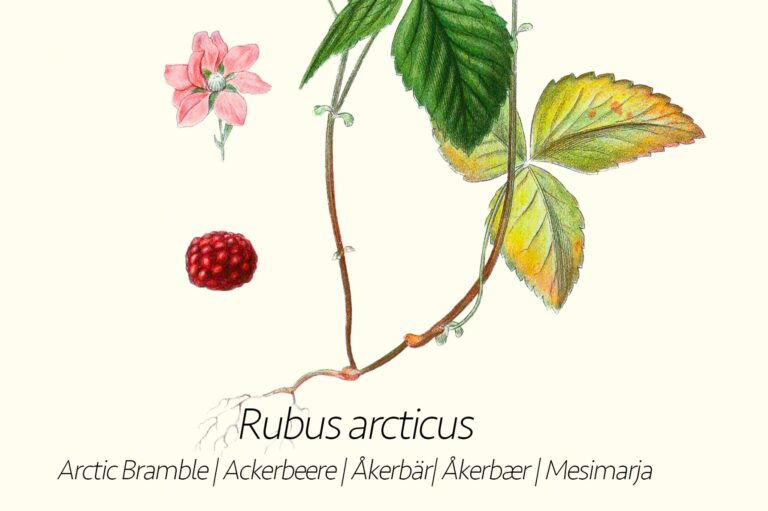
Rubus fruticosus (Blackberry)
is a tall, thorny shrub that is commonly found in woodlands and hedgerows throughout Scandinavia. The fruit is a large, blackberry-like berry that is typically picked in late summer. The berries are known for their sweet and juicy flavor and are often used to make jams, jellies, and pies.
Rubus arcticus (Arctic Bramble)
is a small, creeping shrub that is commonly found growing in Arctic tundra regions throughout Scandinavia. The fruit is a small, blackberry-like berry that is typically picked in late summer. The berries are known for their sweet and tangy flavor and are often used to make jams and jellies.
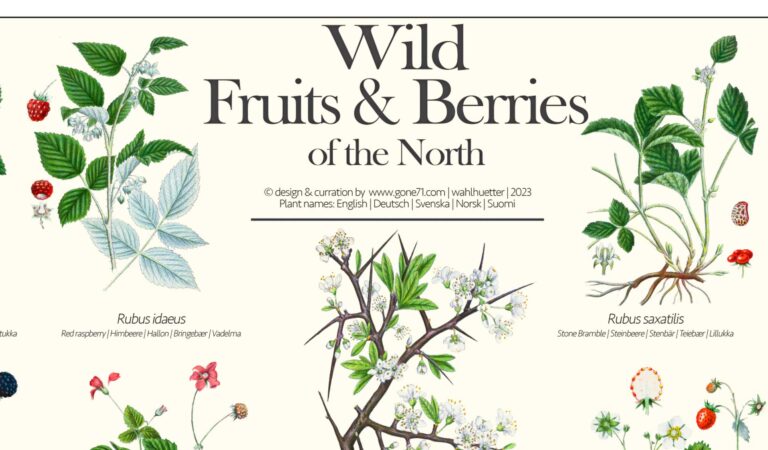
Prunus spinosa (Blackthorn)
is a small, thorny shrub that is commonly found growing in woodlands and hedgerows throughout Scandinavia. The fruit is a small, black, cherry-like berry that is typically picked in late summer. The berries are known for their sour and astringent flavor and are often used to make jams and jellies.
Fragaria vesca (Wild Strawberry)
is a small, creeping perennial that is commonly found growing in woodlands and hedgerows throughout Scandinavia. The fruit is a small, red, strawberry-like berry that is typically picked in late summer. The berries are known for their sweet and juicy flavor and are often used to make jams, jellies, and pies.
Hippophae rhamnoides (Sea Buckthorn)
is a small, thorny shrub that is commonly found growing along coastal regions throughout Scandinavia. The fruit is a small, orange berry that is typically picked in late summer. The berries are known for their tangy and slightly bitter flavor and are often used to make jams

Vaccinium myrtillus (Bilberry)
is a small shrub that grows wild in the forests and mountains of Scandinavia. The fruit is a small, round, blueberry-like berry that is typically picked in late summer. The berries are known for their sweet and juicy flavor and are often used to make jams, jellies, and pies. They are also a popular ingredient in traditional Scandinavian cuisine, being used to make cakes, pancakes, and other desserts.
Vaccinium uliginosum (Bog Bilberry)
is a small shrub that is commonly found growing in bogs and wetland areas throughout Scandinavia. The fruit is a small, red, berry-like fruit that is typically picked in late summer. The berries are known for their sweet and juicy flavor and are often used to make jams, jellies, and pies. They are also a popular ingredient in traditional Scandinavian cuisine, being used to make cakes, pancakes, and other desserts.
Vaccinium vitis-idaea (Lingonberry)
is a small, creeping perennial that is commonly found growing in woodlands and hedgerows throughout Scandinavia. The fruit is a small, red, berry-like fruit that is typically picked in late summer. The berries are known for their tart and tangy flavor and are often used to make jams, jellies, and pies. They are also a popular ingredient in traditional Scandinavian cuisine, being used to make cakes, pancakes, and other desserts.
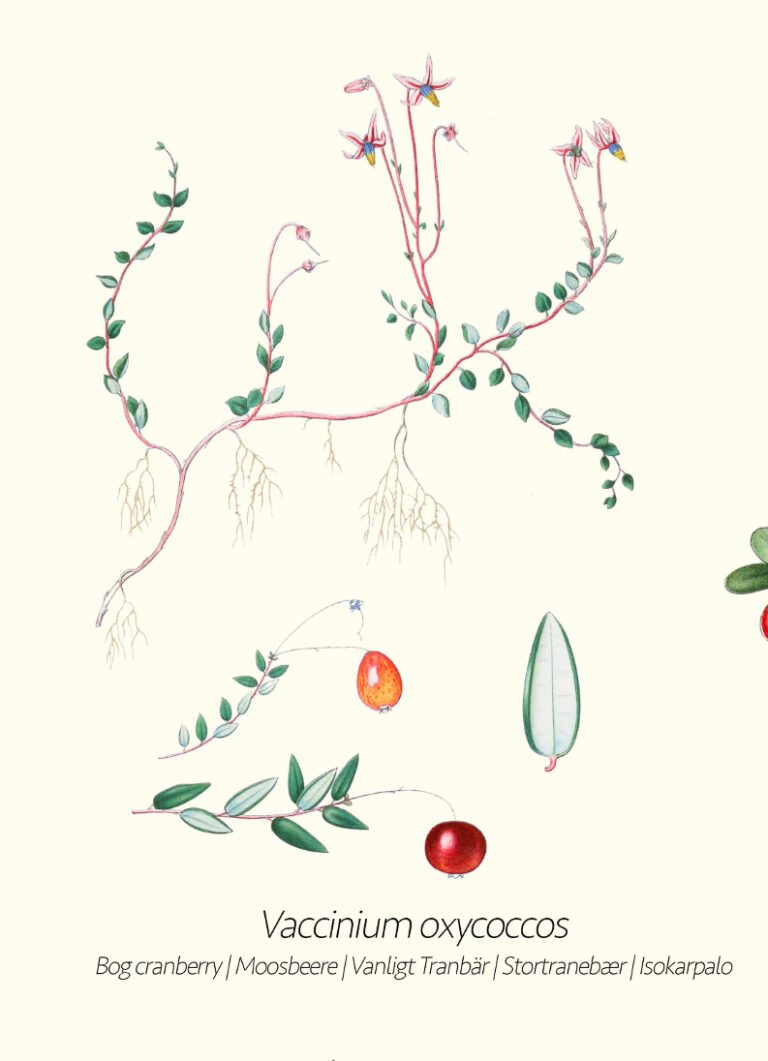
Vaccinium oxycoccos (Bog Cranberry)
is a small, creeping perennial that is commonly found growing in bogs and wetland areas throughout Scandinavia. The fruit is a small, red, berry-like fruit that is typically picked in late summer. The berries are known for their tart and tangy flavor and are often used to make jams, jellies, and pies. They are also a popular ingredient in traditional Scandinavian cuisine, being used to make cakes, pancakes, and other desserts.
Arctostaphylos uva-ursi (Bearberry)
is a small, creeping perennial that is commonly found growing in woodlands and mountains throughout Scandinavia. The fruit is a small, red, berry-like fruit that is typically picked in late summer. The berries are known for their sweet and juicy flavor and are often used to make jams, jellies, and pies. They are also a popular ingredient in traditional Scandinavian cuisine, being used to make cakes, pancakes, and other desserts.
Empetrum nigrum (Crowberry)
is a small, creeping perennial that is commonly found growing in woodlands and mountains throughout Scandinavia. The fruit is a small, black, berry-like fruit that is typically picked in late summer. The berries are known for their tart and tangy flavor and are often used to make jams, jellies, and pies. They are also a popular ingredient in traditional Scandinavian cuisine, being used to make cakes, pancakes, and other desserts.
Prunus avium (Sweet Cherry)
is a small tree that is commonly found growing in woodlands and orchards throughout Scandinavia. The fruit is a small, red, cherry-like fruit that is typically picked in late summer. The cherries are known for their sweet and juicy flavor and are often used to make jams, jellies, and pies. They are also a popular ingredient in traditional Scandinavian cuisine, being used to make cakes, pancakes, and other desserts.
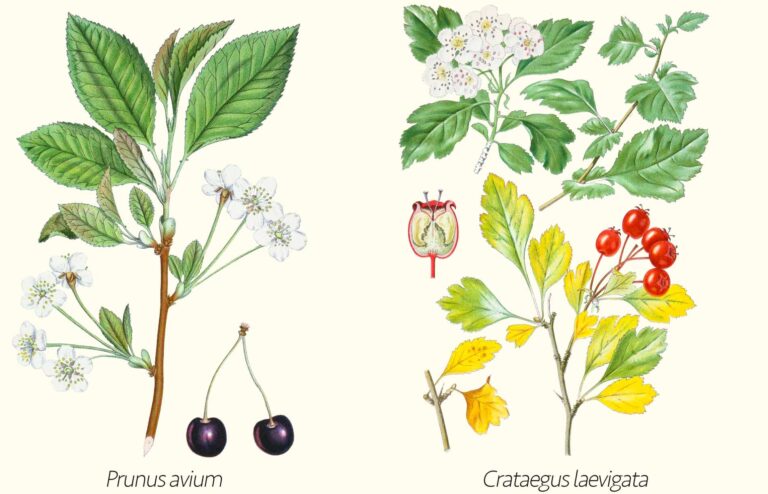
Crataegus laevigata (Hawthorn)
is a small to medium-sized deciduous tree that is commonly found growing in woodlands, hedgerows, and along roadsides throughout Scandinavia. The tree produces small, white flowers in spring, followed by small, red berries in late summer. The berries are used to make jams, jellies, and syrups, and are said to have medicinal properties.
Ribes rubrum (Red Currant)
is a deciduous shrub that is commonly found growing in woodlands and hedgerows throughout Scandinavia. The shrub produces clusters of small, red berries in late spring to early summer. The berries are known for their tart and tangy flavor, and are often used to make jams, jellies, and pies.
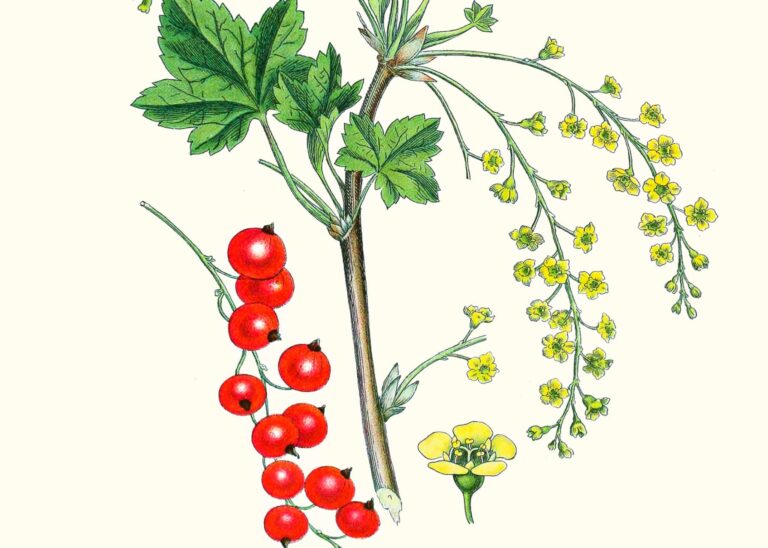
Sorbus aucuparia (Rowan)
is a deciduous tree that is commonly found growing in woodlands and along roadsides throughout Scandinavia. The tree produces clusters of small, white flowers in spring, followed by small, orange-red berries in late summer. The berries are used to make jams, jellies, and syrups, and are also popular with birds and wildlife.
Ribes nigrum (Black Currant)
is a deciduous shrub that is commonly found growing in woodlands and hedgerows throughout Scandinavia. The shrub produces clusters of small, black berries in late spring to early summer. The berries are known for their strong, tart flavor, and are often used to make jams, jellies, and pies.
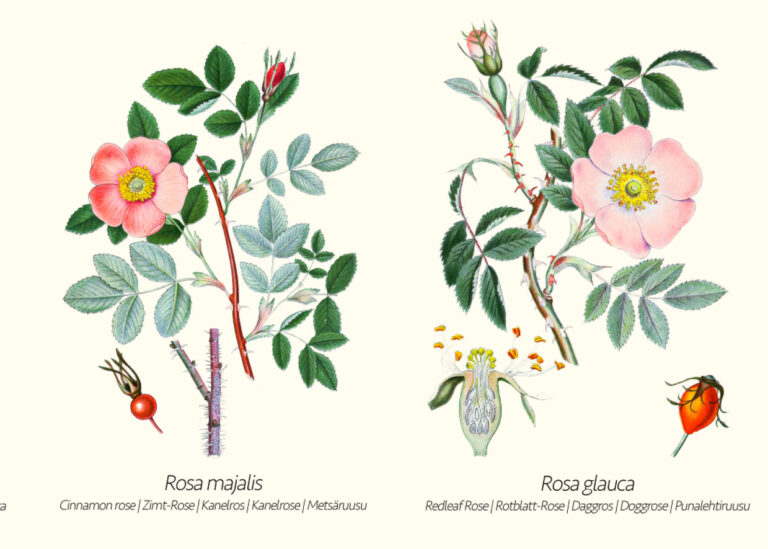
Rosa majalis (Cinnamon Rose)
is a deciduous shrub that is commonly found growing in woodlands and along roadsides throughout Scandinavia. The shrub produces clusters of small, pink to red flowers in spring, followed by small, hips in fall. The hips are used to make jams, jellies, and syrups, and are said to have medicinal properties.
Rosa glauca (Redleaf Rose)
is a deciduous shrub that is commonly found growing in woodlands and along roadsides throughout Scandinavia. The shrub produces clusters of small, pink to red flowers in spring, followed by small, hips in fall. The hips are used to make jams, jellies, and syrups, and are said to have medicinal properties.
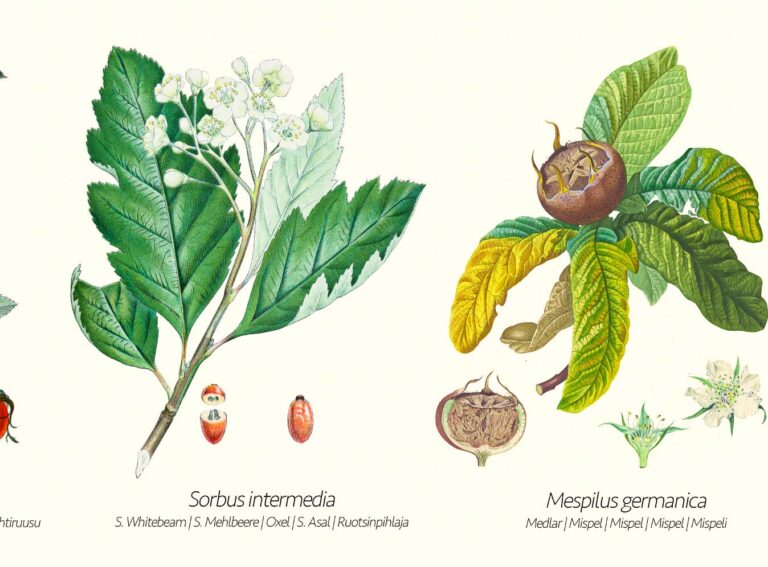
Sorbus intermedia (S. Whitebeam)
is a deciduous tree that is commonly found growing in woodlands and along roadsides throughout Scandinavia. The tree produces clusters of small, white flowers in spring, followed by small, red berries in late summer. The berries are used to make jams, jellies, and syrups, and are also popular with birds and wildlife.
Mespilus germanica (Medlar)
is a deciduous tree that is commonly found growing in woodlands and along roadsides throughout Scandinavia. The tree produces clusters of small, white flowers in spring, followed by small, brown fruits in fall. The fruits are typically picked when they are overripe and soft, and are used to make jams, jellies, and syrups.
“Digital foraging”
Introducing “digital foraging”, my latest project that delves into the vast and untapped world of digital information. With a sheer endless amount of historic images and resources available online, the possibilities are endless. The artwork you see here is a perfect example of what can be achieved through “digital foraging”.
Unfortunately it takes much more than just a quick search to get the results you see here. It takes hours of research, technical know-how and a keen eye to find the right images, in the right resolution, and format. And that’s just the beginning. The real work starts with processing and manipulating the images to create something new and unique.
For me, this is what “digital foraging” is all about. The thrill of the hunt, the excitement of discovery and the satisfaction of creating something new and beautiful from what was once forgotten. It’s also a modern take on the traditional art of foraging, and I can’t wait to see what else can be found in the vast depths of the digital world.
Find more insights about selected Scandinavian berries
in this article
↓↓↓
The original images
The beauty of historic lithographic illustrations lies in the intricate details and expert craftsmanship that goes into each piece. These drawings are true works of art of their own and deserve to be showcased. With a vast array of images hidden in archives, it’s a bit like a treasure hunt for these historic prints.
These images offer also a glimpse into the past, showing us how botanical illustrations were created and used before the advent of photography. Take a look at the sample photos provided and you’ll see what I mean. The intricate details of each leaf, petal, and stem are captured with stunning accuracy. The colors are rich and vibrant, making these illustrations truly stand out as works of art.
Historic prints of (Scandinavian) fruits & berries
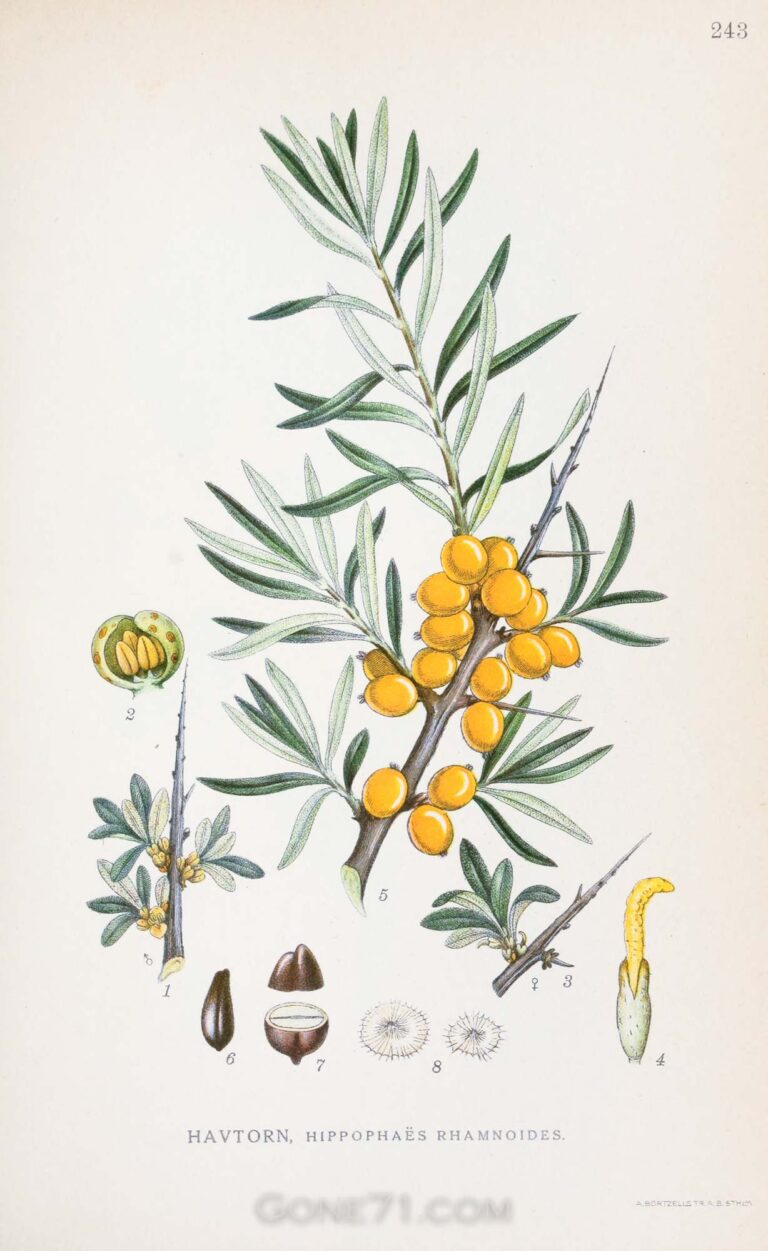
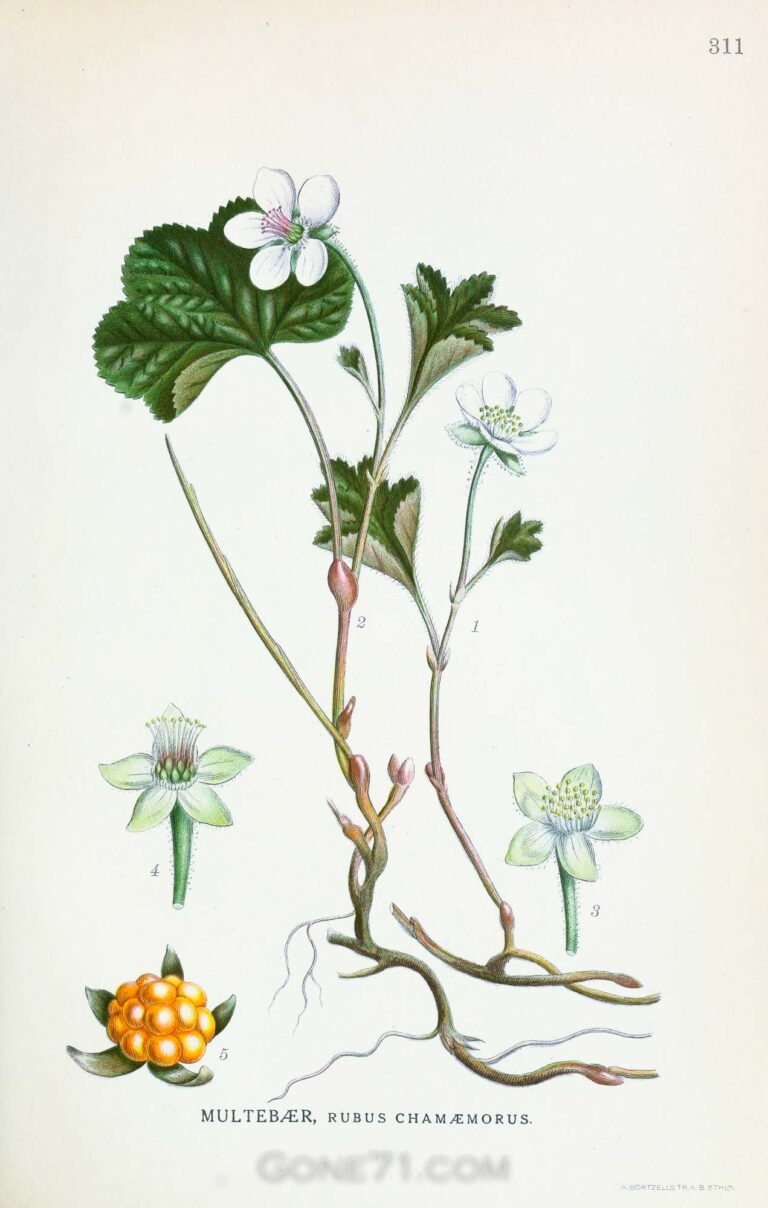
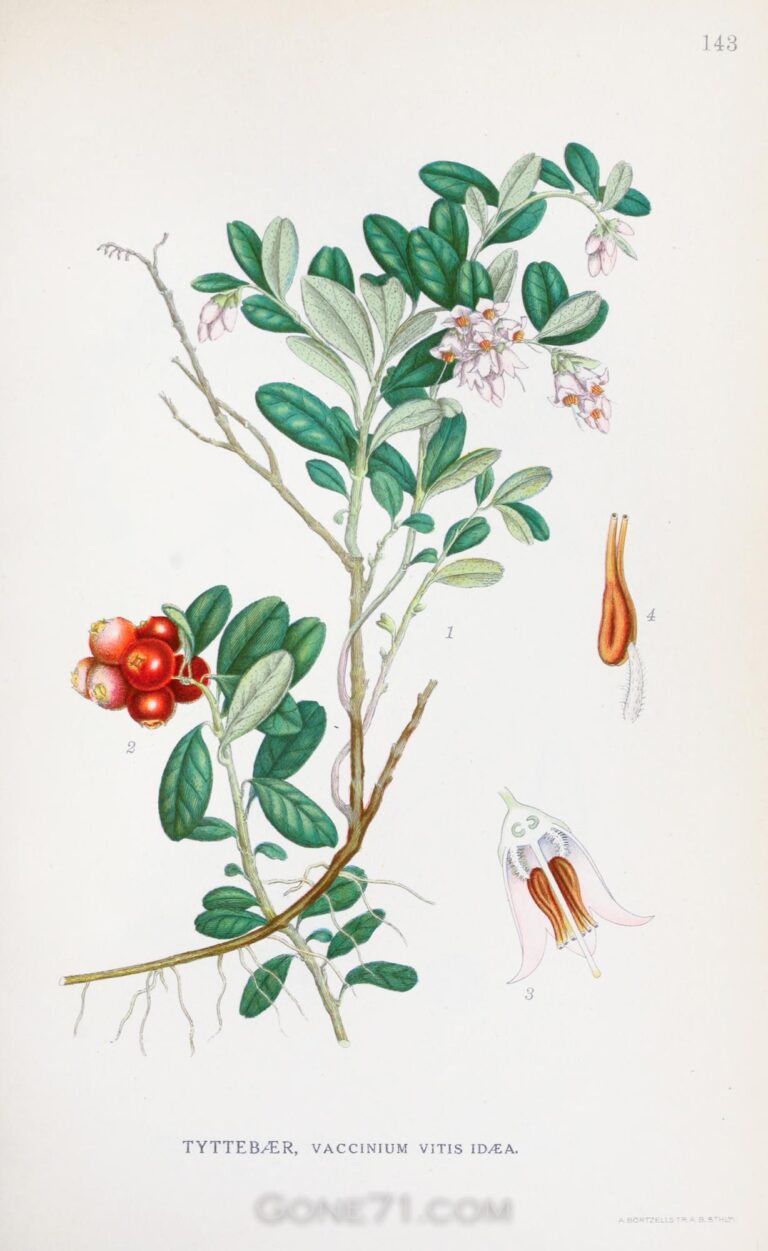
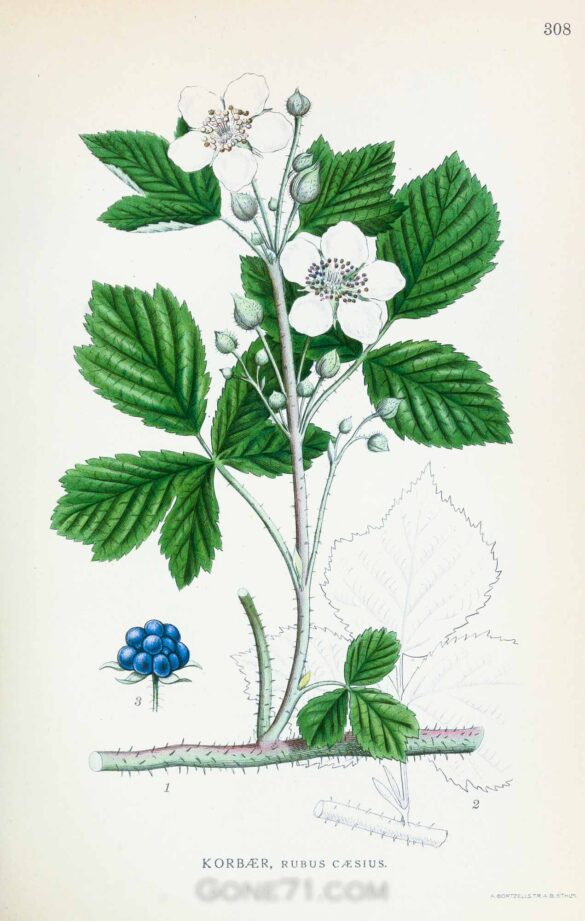
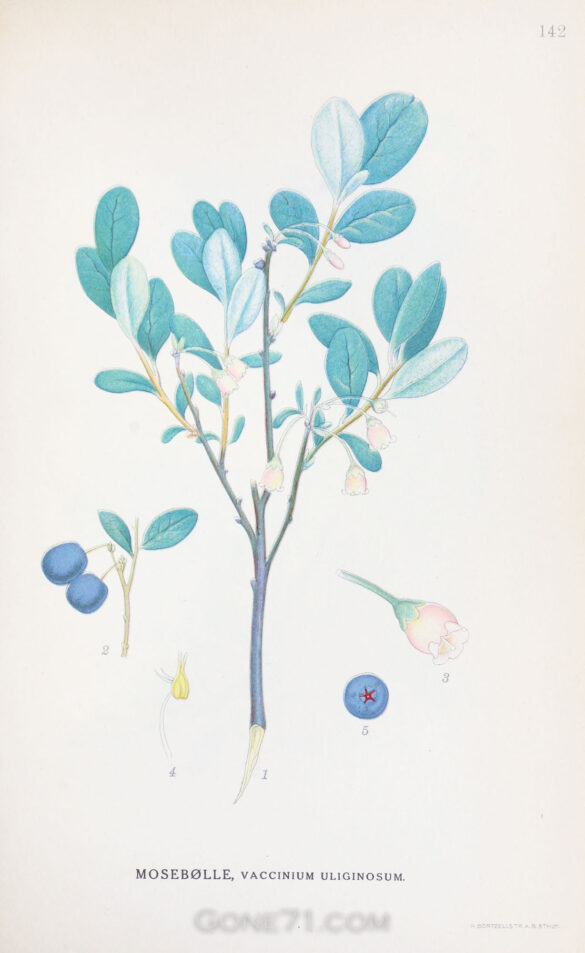
Let us know what you think of these images and feel free to give us suggestions on which topics we should delve into next.
Find some inspiration here
↓↓↓


